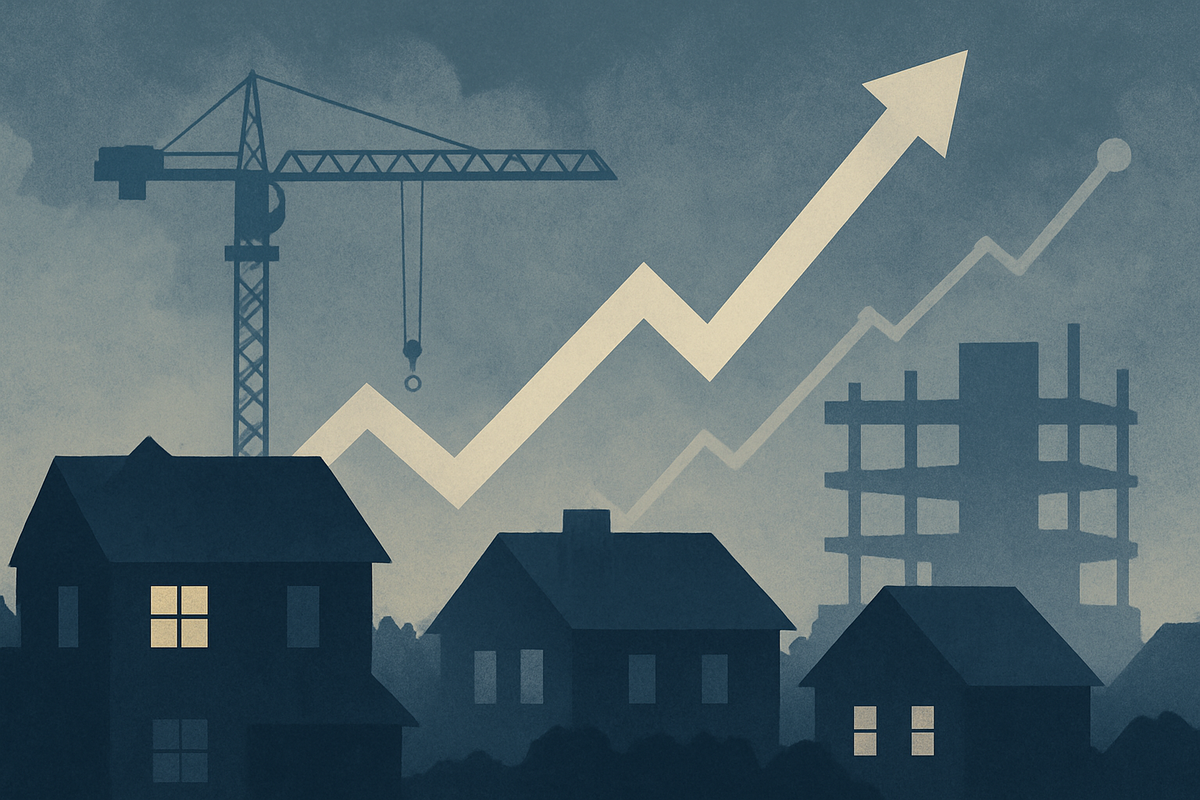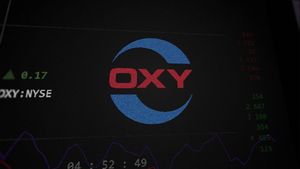
Washington D.C. – October 2, 2025 – The United States housing market is bracing for a potential cool-down as average long-term mortgage rates have ticked up for the second consecutive week, reaching 6.34%. This latest increase, announced by Freddie Mac, signals a tightening lending environment that could further exacerbate affordability challenges for prospective homebuyers and send ripple effects through the construction and commodities sectors. While still below the 52-week average of 6.71%, this sustained upward movement in borrowing costs is a critical indicator of shifting market dynamics, forcing both consumers and industry players to reassess their strategies.
The immediate implication of this rise is a further squeeze on housing affordability. For many Americans, higher mortgage rates translate directly into significantly increased monthly payments, effectively pricing a substantial portion of potential buyers out of the market. This comes at a time when only 28% of US homes are considered affordable for the typical household. The resultant dampening of housing demand is expected to moderate home price growth, with national appreciation projected at around 3% for 2025, and some localized markets potentially experiencing flat or even slightly declining prices in the fourth quarter.
Detailed Market Movements and Influential Factors
The current average 30-year fixed-rate mortgage at 6.34% represents a slight uptick from 6.30% the previous week and stands notably higher than the 6.12% recorded a year prior, on October 2, 2024. This movement is part of a complex timeline of events shaped by Federal Reserve policy, inflation, and bond market sentiment.
The housing market has been in a slump since 2022, when mortgage rates began their significant ascent from historic lows. Sales of previously occupied homes plummeted to nearly 30-year lows in 2024, with 2025 figures continuing to lag behind those of the preceding year. In late 2024, the Federal Reserve initiated its first interest rate cut in a year, followed by another in December, responding to a cooling labor market. However, mortgage rates surprisingly rose into early 2025, hovering near 6.8% for much of the year, exceeding the 2024 average.
A brief respite occurred in late July 2025, with rates declining in anticipation of further Fed cuts. Indeed, in September 2025, the Federal Reserve reduced the federal funds rate by a quarter of a percentage point to a range of 4% to 4.25%, citing slowed job gains and persistent inflation. This temporarily pushed 30-year mortgage rates down to 6.34% in early September, triggering a surge in refinancing applications. Rates continued to decline to 6.26% by September 18th, marking a four-week downward streak, before reversing course to 6.30% by September 25th, and ultimately settling at the current 6.34% on October 2, 2025. This latest increase ends the brief period of declining rates and reinforces the volatility inherent in the current financial landscape.
Key players closely watching and influencing these movements include Freddie Mac, which provides weekly mortgage rate surveys, and the Federal Reserve, whose monetary policy decisions indirectly steer mortgage rates. The bond market investors also play a crucial role, as mortgage rates often track the yield on long-term government bonds, particularly the 10-year Treasury yield. Mortgage lenders then set specific rates based on these market conditions, while homebuyers and homeowners are directly impacted by the resulting affordability and refinancing opportunities. The Mortgage Bankers Association (MBA) also offers critical industry insights, noting a "sizeable drop in refinance applications" following the latest rate bump. Adding another layer of uncertainty, a government shutdown, commencing in October 2025, could further delay economic reports and complicate the Fed's policy decisions.
Winners and Losers in a Shifting Market
The recent uptick in mortgage rates creates a complex environment, yielding both challenges and opportunities for public companies across various sectors.
Companies Facing Headwinds:
- Mortgage Lenders and Brokers: These entities are highly sensitive to rate fluctuations. A sustained period of higher rates typically leads to reduced loan origination volumes for new purchases and a significant drop in refinancing activity, directly impacting their revenue and profitability. Rocket Companies (NYSE: RKT), a major mortgage lender, could see its loan origination volumes challenged, despite recent revenue growth.
- Real Estate Brokerages: Fewer home sales transactions translate directly to lower commission income. Companies like Douglas Elliman Inc. (NYSE: DOUG) and Redfin Corporation (NASDAQ: RDFN) are likely to experience continued slowdowns in transaction volume, impacting their top lines.
- Home Furnishings and Appliances Retailers: A decrease in home sales means fewer new homeowners needing to furnish or equip their residences, potentially reducing demand for these goods. Whirlpool Corp. (NYSE: WHR), a major appliance manufacturer, could see a dip in sales tied to new home purchases. While The Home Depot, Inc. (NYSE: HD) and Lowe's Companies, Inc. (NYSE: LOW) also benefit from renovation activity, a significant drop in new home sales could still negatively impact their overall sales linked to initial home setups.
Companies Showing Resilience or Potential Gains:
- Homebuilders: Counterintuitively, many homebuilders have demonstrated resilience and even strong performance. The severe shortage of existing homes for sale, driven by current homeowners being "locked in" to lower rates, pushes buyers towards new construction. Builders can also offer incentives like mortgage rate buy-downs, making new homes more attractive. PulteGroup (NYSE: PHM), D.R. Horton (NYSE: DHI), Lennar (NYSE: LEN), Toll Brothers (NYSE: TOL), and KB Home (NYSE: KBH) are examples of companies that have reported strong earnings or shown resilience in this environment.
- Residential Real Estate Investment Trusts (REITs): If homeownership becomes less affordable, demand for rental properties tends to increase, benefiting apartment REITs. Companies like Equity Residential (NYSE: EQR) and AvalonBay Communities (NYSE: AVB) could see increased demand and pricing power for their rental units. Mortgage REITs (mREITs) like Apollo Commercial Real Estate Finance, Inc. (NYSE: ARI) may also find opportunities if the economy strengthens.
- Home Improvement Retailers: Existing homeowners, facing higher costs to move, may opt to renovate their current homes instead. This trend could bolster sales for The Home Depot, Inc. (NYSE: HD) and Lowe's Companies, Inc. (NYSE: LOW) from renovation and repair projects, partially offsetting any decline from new home construction.
- Construction Technology/Software Companies: As builders navigate higher material and financing costs, they will increasingly seek efficiencies. Companies offering technology solutions for project management and cost reduction, such as Autodesk (NASDAQ: ADSK) and Trimble (NASDAQ: TRMB), could see increased adoption of their tools.
Impact on Construction-Related Commodities:
Rising interest rates generally lead to increased construction costs, affecting prices for materials like lumber, steel, concrete, and oriented strand boards (OSB). This is exacerbated by ongoing supply chain issues and new tariffs, such as the 25% duties on imported steel and aluminum enacted in February 2025 and potential 50% duties on copper. Higher borrowing costs for developers can deter new projects, potentially moderating demand for these raw materials over the long term. However, robust government infrastructure investments and sustained non-residential construction activity could provide a cushion, maintaining demand for products from companies like Vulcan Materials Company (NYSE: VMC), Martin Marietta Materials Inc. (NYSE: MLM), Cemex S.A.B. De C.V. (NYSE: CX), Owens Corning (NYSE: OC), Eagle Materials Inc. (NYSE: EXP), Louisiana-Pacific Corporation (NYSE: LPX), and UFP Industries, Inc. (NASDAQ: UFPI).
Wider Significance and Historical Context
The 6.34% mortgage rate in October 2025 is more than just a number; it signifies a pivotal moment in broader industry trends, with ripple effects extending across the economy.
Broader Industry Trends: The "lock-in effect" remains a dominant force, as homeowners with historically low rates are reluctant to sell, contributing to a constrained supply of existing homes. This pushes buyers towards new construction, even as builders face increased financing costs and respond by focusing on smaller, more cost-effective homes and offering incentives. The overall lending and financial services sectors are navigating reduced origination volumes, forcing innovation in product offerings to remain competitive.
Ripple Effects: Competitors in the mortgage lending and real estate brokerage sectors will face intensified competition for a shrinking pool of clients. Home builders and material suppliers will continue to grapple with high borrowing costs and fluctuating demand, while related industries like home improvement may see a boost from homeowners opting to renovate rather than move.
Regulatory and Policy Implications: The Federal Reserve's monetary policy, particularly its federal funds rate target, remains a key indirect influencer of long-term mortgage rates. The Fed's recent rate cuts in late 2024 and September 2025, driven by concerns over a weakening labor market and inflation, demonstrate its delicate balancing act. A government shutdown, which commenced around this time, could further delay economic reports and complicate the Fed's decisions, creating market uncertainty. High mortgage rates and affordability challenges could also prompt calls for new government initiatives to boost homeownership, such as first-time homebuyer programs or revised mortgage insurance policies.
Historical Precedents: The current 6.34% rate, while challenging, is far below the exorbitant rates of the 1970s and 1980s, which peaked at 16.64% in 1981 amidst aggressive inflation-fighting by the Federal Reserve. However, it is significantly higher than the historically low rates seen in the 2000s and 2010s, and particularly the sub-3% rates during the COVID-19 pandemic in 2021. The current environment mirrors past periods of rising rates characterized by reduced homebuyer demand and a slowdown in sales, but with the unique modern context of coming off extremely low rates, which amplifies the "lock-in effect." Historically, such periods have spurred innovation in financing and adjustments in builder strategies, a trend visible in today's market with a focus on smaller homes and mortgage rate buydowns.
The Road Ahead: Navigating Uncertainty
The US housing and construction markets are poised for a period of strategic adaptation and recalibration rather than rapid growth. The 6.34% mortgage rate is a significant factor shaping both short-term and long-term possibilities.
Short-Term (Late 2025 - 2026): The immediate future points to cautious rebalancing. Housing affordability will remain a primary concern, contributing to a "lock-in effect" among existing homeowners and limiting supply. Home price growth is expected to be modest (2-4% annually), with some potential for slight national declines before a rebound. Residential construction, after two years of decline, is projected to rebound with a 12% growth in 2025, driven by stabilizing inflation and easing rates, though single-family starts may see slight declines before a stronger recovery in 2027. Construction commodity costs will likely remain elevated due to supply chain issues and tariffs.
Long-Term (2027 and Beyond): The market is expected to settle into a "new normal." Mortgage rates could gradually recede to a more manageable 5.5% to 6.0% range by late 2028-2029. A buyer's market might emerge between mid-2026 and mid-2027 if inventory continues to increase. Nominal home prices are unlikely to decline significantly but will appreciate at a slower, more sustainable pace, supported by persistent low inventory and demographic drivers.
Strategic Pivots: Homebuilders are already adopting "asset-light, land-light" models, focusing on cost containment, efficiency, and innovative construction methods like modular building. They are also increasingly offering financial incentives such as mortgage rate buy-downs and focusing on smaller, energy-efficient home designs. Buyers may need to take a longer-term view, anticipating potential rate reductions and refinancing opportunities.
Market Opportunities and Challenges: Opportunities include potential increases in refinancing activity as rates ease, sustained demand for multifamily and affordable housing, and growth in specific non-residential construction segments like data centers and infrastructure. Challenges remain significant, notably the affordability crisis, the pervasive "lock-in effect," volatile and elevated construction costs (exacerbated by tariffs), economic uncertainty, and buyer hesitation.
Potential Scenarios: The most likely baseline scenario is a soft landing/gradual recalibration, where the market experiences a prolonged rebalancing with modest price appreciation and gradual easing of rates. A stagnation scenario could occur if "higher-for-longer" rates persist, leading to prolonged low sales and a significant slowdown in construction. A less likely, but possible, recessionary scenario could trigger a plunge in non-residential construction and further reductions in housing market activity, though a drastic housing crash is considered unlikely due to low inventory.
Comprehensive Wrap-Up and Investor Outlook
The recent increase in long-term US mortgage rates to 6.34% signals a critical juncture for the housing market and construction industry. The primary takeaway is a continued tightening of lending conditions, which will undoubtedly challenge housing affordability and moderate price growth. While some buyer confidence has emerged from earlier rate declines, this latest uptick could pause market activity and underscore the ongoing volatility.
Moving forward, the market will be characterized by a delicate rebalancing act. Investors should watch for several key indicators: the Federal Reserve's future interest rate decisions and their impact on bond yields, the trajectory of inflation, and any changes in government policy related to housing or tariffs on construction materials. The "lock-in effect" will continue to shape inventory levels, while builders' ability to innovate with incentives and cost-efficient construction methods will be crucial for maintaining sales.
The interplay of these factors will determine whether the market achieves a soft landing, experiences prolonged stagnation, or faces a more severe downturn. Companies with strong balance sheets, diversified revenue streams (e.g., in non-residential construction or home improvement), and agile business models will be best positioned to navigate these uncertain waters. For investors, a discerning eye towards companies that can adapt to evolving consumer demands and manage rising costs will be paramount in the coming months.
This content is intended for informational purposes only and is not financial advice





